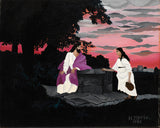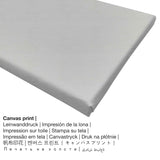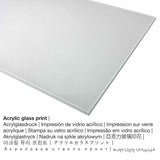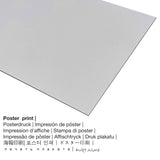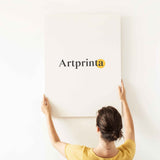Horācijs Pipins, 1940. gads - Kristus un Samarijas sieviete - tēlotājas mākslas apdruka
PVN iekļauts. Piegāde aprēķināta Pie izrakstīšanās
Mākslas izstrādājuma specifikācijas
In 1940 Horacijs Pipins painted the piece of art. The over 80 years old original was made with the size: Kopumā: 19 3/4 x 24 1/4 collas (50,2 x 61,6 cm) un tika krāsots ar barotni eļļa uz audekla. Pārvietojot, mākslas darbu var apskatīt Bārnsa fonda digitālā kolekcija. The modernā māksla public domain piece of art is provided with courtesy of Courtesy of the Barnes Foundation, Merion and Philadelphia, Pennsylvania.The creditline of the artpiece is: . On top of that, alignment of the digital reproduction is ainava un sānu attiecība ir 1.2: 1, kas to nozīmē garums ir par 20% garāks nekā platums.
Atlasiet produkta materiālu, kuru vēlaties iegūt
In the dropdown lists next to the article you can choose the size and material of your choice. Select your preferred size and material among the following alternatives:
- Metāls (alumīnija dibondraksts): Aluminium Dibond prints are metal prints with a true depth - for a modern look and non-reflective surface structure. Colors are luminous in the highest definition, the details of the print are crisp and clear. The print on aluminium is one of the most popular entry-level products and is a truly modern way to display fine art prints, as it puts 100% of the viewer’s attention on the artwork.
- Akrila stikla apdruka (ar reālu stikla pārklājumu): An print on acrylic glass, which is sometimes described as a UV print on plexiglass, will turn your favorite original artwork into décor and offers a viable alternative option to dibond and canvas prints. Your work of art is being custom-made with state-of-the-art UV direct print technology. The major advantage of an acrylic glass fine art print is that contrasts as well as granular image details become exposed due to the subtle gradation.
- Plakāta druka uz audekla materiāla: A poster print is a UV printed sheet of canvas with a slight structure on the surface. Please keep in mind, that depending on the absolute size of the canvas poster print we add a white margin of approximately 2 - 6cm round about the painting in order to facilitate the framing.
- Audekla druka: A printed canvas, which should not be mistaken with a painting on a canvas, is a digital copy printed from a UV direct printing machine. Canvas prints are relatively low in weight. This means, it is easy and straightforward to hang up your Canvas print without extra wall-mounts. A canvas print is suitable for any kind of wall in your house.
Svarīga piezīme: We try what we can to describe the art products as clearly as possible and to showcase them visually. Nonetheless, the pigments of the printed materials and the printing may vary slightly from the image on your monitor. Depending on the settings of your screen and the nature of the surface, not all color pigments are printed 100% realistically. Bearing in mind that the are processed and printed by hand, there might also be minor deviations in the exact position and the size of the motif.
Strukturētas preces informācija
| Produktu kategorija: | tēlotājas mākslas druka |
| Reprodukcijas metode: | digitālā reproducēšana |
| Ražošanas process: | UV druka / digitālā druka |
| Izcelsme: | Vācu ražots |
| Krājumu veids: | produkcija pēc pieprasījuma |
| Paredzētais lietojums: | sienas attēls, sienas galerija |
| Attēla orientācija: | ainavas izlīdzināšana |
| Aspect ratio: | 1.2: 1 (garums, platums) |
| Sānu malu attiecības ietekme: | garums ir par 20% garāks nekā platums |
| Produkta materiāla izvēle: | metāla apdruka (alumīnija dibonds), akrila stikla apdruka (ar īsta stikla pārklājumu), audekla apdruka, plakāta druka (audekla papīrs) |
| Audekls uz nestuvju rāmja (audekla druka) izmēru varianti: | 60x50cm - 24x20 ", 120x100cm - 47x39", 180x150cm - 71x59 " |
| Akrila stikla apdrukas (ar īstu stikla pārklājumu) izmēri: | 60x50cm - 24x20 ", 120x100cm - 47x39", 180x150cm - 71x59 " |
| Plakātu drukas (audekla papīrs) varianti: | 60x50cm - 24x20 ", 120x100cm - 47x39" |
| Alumīnija apdruka (alumīnija dibona materiāls): | 60x50cm - 24x20 ", 120x100cm - 47x39" |
| Mākslas reprodukcijas ierāmēšana: | nav pieejams |
Mākslas darbu gabals
| Mākslas darbs: | "Kristus un Samarijas sieviete" |
| Klasifikācija: | glezna |
| Plaša kategorija: | modernā māksla |
| Laiks: | 20th gadsimts |
| Izveidots: | 1940 |
| Aptuvenais mākslas darba vecums: | vairāk nekā 80 gadus vecs |
| Mākslas darba oriģināls: | eļļa uz audekla |
| Mākslas darba oriģināls: | Kopumā: 19 3/4 x 24 1/4 collas (50,2 x 61,6 cm) |
| Muzejs: | Bārnesa fonds |
| Muzeja atrašanās vieta: | Filadelfijā, Pensilvānijā, Amerikas Savienotajās Valstīs |
| mājas lapa muzejs: | Bārnesa fonds |
| Mākslas darba licence: | publiski |
| Pieklājīgi no: | Ar Barnes fonda atbalstu, Merion un Filadelfija, Pensilvānija |
Mākslinieka pārskats
| Mākslinieks: | Horacijs Pipins |
| Zināms arī kā: | hippin h., Pippin, Horace Pippin, Pippin Horace |
| Dzimums: | vīrietis |
| Mākslinieka tautība: | Amerikāņu |
| Mākslinieka darbi: | gleznotājs |
| Valsts: | ASV |
| Mākslinieka klasifikācija: | mūsdienu mākslinieks |
| Miris vecumā: | 58 gadiem |
| Dzimšanas gads: | 1888 |
| Dzimis (vietā): | West Chester, Čestera grāfiste, Pensilvānija, Amerikas Savienotās Valstis |
| Nāves gads: | 1946 |
| Nāves vieta: | West Chester, Čestera grāfiste, Pensilvānija, Amerikas Savienotās Valstis |
Autortiesības ©, Artprinta.com (Artprinta)
Additional artwork information by the museum's website (© Copyright - by Barnes Foundation - Bārnesa fonds)
The picture shocks by its drama, which is due primarily to Pippin's original use of color. The intense gradations of fuchsia and gray in the sky meet dramatically at the horizon with an intense purplish red against the green-blacks of the foliage. The placement of Christ's crisp, silhouetted purple cloak, firmly situated as if in a niche between the well and stones and the dark foliage behind, is a powerful color statement.Barnes believed that Pippin had been influenced by the composition of a painting formerly attributed to Tintoretto (Christ and the Woman of Samaria, BF823) of the same subject in the Foundation. The painting conceivably has another source rooted in African American experience, specifically, Pippin's deep religious faith. One of the fundamental aspects of Barnes's attraction to Pippin's work and his reference to its "counterparts in the Spirituals of the American Negro" was their shared love for the powerful emotions evoked by the simplicity, directness, and rhythms of that indigenous music. It is likely that Pippin, familiar with a wide repertoire of accompanied and a cappella songs, knew the traditional spiritual "Jesus Met the Woman at the Well". Richard J. Wattenmaker, American Paintings and Works on Paper in the Barnes Foundation (Merion, PA: The Barnes Foundation; New Haven: Yale University Press, 2010), 307-9.

